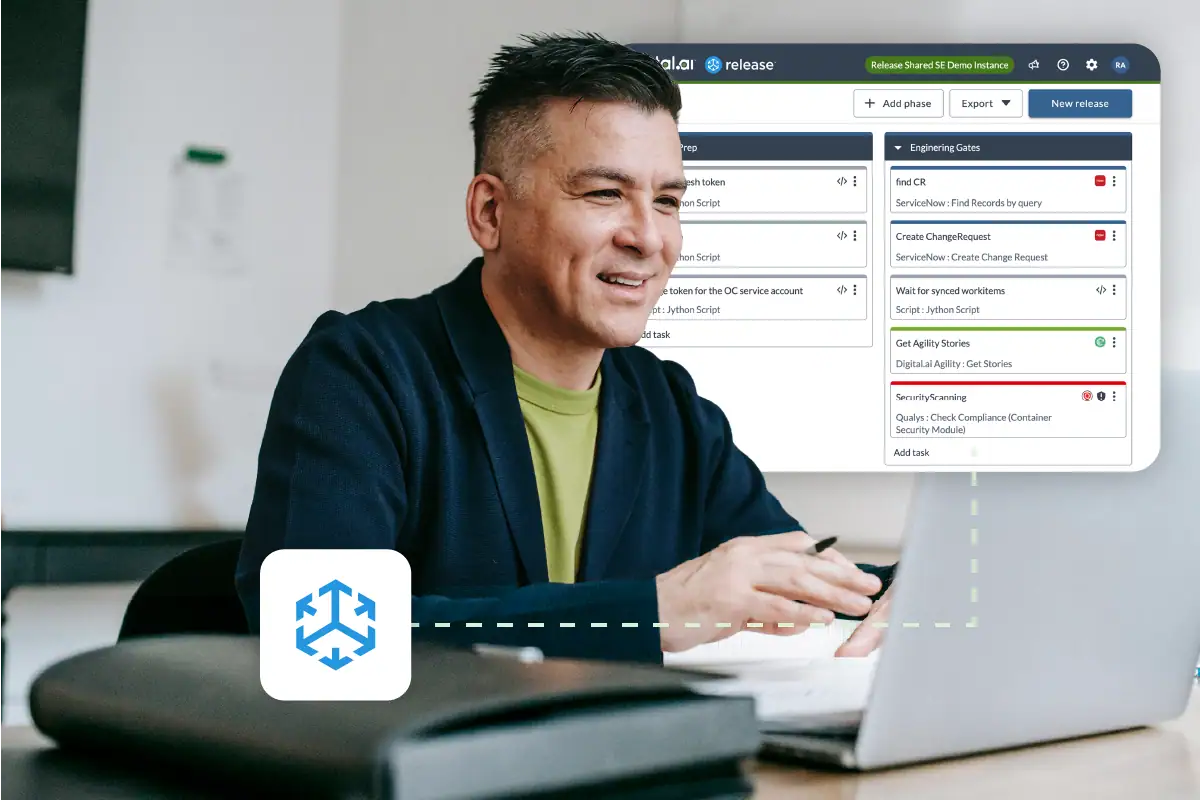Table of Contents
Related Blogs
Tool integrations allow for smoother transitions from team to team during a sprint, as well as higher visibility across the entire toolchain.
Organizations can view the entirety of the tools and platforms they used to develop, release, and update products as a collective “toolchain”. Essentially, the toolchain is what pulls together separate individual solutions into a single combined end-to-end process.
In many cases, this toolchain may be made of individual siloed environments — separate tools operated by separate teams for a collective cause. Traits of siloing include a need to adjust file formats during team handoffs and a lack of visibility from one environment to another. This siloing generates friction, which can lead to longer lead times, poor coordination and alignment between teams, a lack of visibility for process performance, and difficulty when performing audits or ensuring compliance.
Increasingly, individual DevOps tools are being integrated with one another, facilitating a more unified and connected toolchain. Integrations can be built-in, such as when a program like Jira is capable of integrating directly with a GitHub repository straight “out of the box”. Integrations can also be custom-built, allowing an organization to create a bridge between tool environments. The advantage of built-in integrations is that they are part of the product, supported and maintained by the vendor. On the other hand, customer solutions provide flexibility, but require time and effort to build and maintain.
By choosing tools that seamlessly integrate as part of the overall DevOps solution, either through pre-integrated tools or custom integrations, organizations can achieve more reliable release processes. Tool integrations allow for smoother transitions from team to team during a sprint, as well as higher visibility across the entire toolchain.
Overall, organizations can seek improved performance, compliance, and transparency with a toolchain that is more integrated and more cohesive as a whole. They can start the process of improving toolchain integrations by looking for problem areas that are a priority to solve and then addressing these problems through the use of pre-built or custom-built integrations.
Disconnected tools can lead to inefficiencies, bottlenecks, and gaps in visibility
The primary reason to invest in a more integrated (or wholly integrated) toolchain is to address persistent problems leading to undesirable outcomes.
These problems may include:
- Lack of visibility
- Manual handoffs are slowing down the release process
- Persistent human error factor, leading to failed releases
- Teams spending a lot of time on work that could easily be handled by an automated integration
Many of these challenges could be stemming from multiple areas of performance within the organization. However, a lack of integrations for toolsets could be causing some problems to emerge and others to worsen.
Looking at a product that faces a high escaped defect ratio as an example, the organization can isolate the sources of defects to a specific team or stage of DevOps, and they can then take measures to improve build quality, testing, or the core architecture issues that may be giving rise to defects that emerge post-release.
However, all of these efforts can be confounded by poor visibility across the DevOps toolchain. Further, all of their most obvious solutions can be made more difficult to implement without ready integrations, especially when it comes to introducing more tests mid-development.
The drive to ameliorate these common issues with integrations should also increase exponentially when the needed integration solutions readily exist and can be quickly leveraged.
Benefits to an integrated toolchain
Toolchain integrations provide an extended array of beneficial outcomes, all of which together contribute to a more efficient process with better compliance and improved performance results.
Ready sharing of DevOps data across the entire toolchain realizes the following benefits:
- The organization can monitor metrics to derive actionable insights, allowing for targeted process improvements and diligent workflow management. They can also improve visibility across processes and have the data available to reduce bottlenecks and generate visualizations for the entire team.
- The toolchain generates data as a complete, end-to-end system of record, recording each step of the entire release process without any gaps. Having the details of each of the tools and processes in one place makes proving compliance easier for audits, which is perfect for highly regulated industries.
- The process has higher reliability due to increased automation. The correct steps will be run each time without the need for manual handoffs or custom scripting.
- Having a robust, integrated process makes it easier to adapt to future needs. For example, with a solution such as Digital.ai Release, adding new tools and integrations to the toolchain is easy as the organization’s needs change. With a patchwork of separate tools, needed integrations must be built with each major environmental change.
- The toolchain abstracts the process from the individual tools. For example, an end-to-end release process can be built with stages like CI, testing, security, deployment. The framework for this process can stay the same even if tools are changed or if parts are removed. This idea is similar to a factory production line. You do not need to change the entire line if one machine is replaced or upgraded. However, if it is simply a loosely organized set of machines, making a change has a lot more impact.
- Individual teams become part of an end-to-end process. Their visibility extends beyond their own tool to the overall process. This view allows teams to better understand how they fit into the bigger picture and deliver value to the process. They can then optimize and improve in ways that help the overall global process rather than simply their local tools, which may not change the outcome.
Toolchain integrations can enable powerful analytics insights
One major challenge of using multiple tools is that they can generate disparate systems of record. Each system is, usually, capable of reporting on its own functions, but this is not the same as being able to apply analytics to a collective pool of DevOps data.
True analytics involves data aggregated from all systems of record. This allows visibility without bias, blind spots, or limitations on analysis. AI-backed analytics for DevOps can pull together data from all relevant sources using data adapters for seamless import and aggregation. Business users can then access this data through intuitive dashboards.
Having true analytics capabilities for DevOps data provides not just a single source of truth but a source of inspiration. DevOps leaders can visualize areas of poor performance or metrics that indicate bottlenecks. Compliance and audit reporting is another case to mention here. By gathering all of the end-to-end data, highly regulated industries can easily produce audit reports of everything that occurred for each release.
Aggregated data can also be analyzed using AI/ML techniques. As an example capability, the organization can quantify the risk of production problems for a given change by using historical data to model the drivers of change risk. Analyzing all factors of a change and comparing it to historical data can allow an AI/ML model to objectively score a given change’s risk of problems
Another example capability for DevOps analytics would be identifying process improvement opportunities through visualized reporting. This can be accomplished using metrics to identify bottlenecks in the process, or specific groups of tasks that tend to take longer than others.
Without these integrated analytics capabilities, DevOps leaders may have questions that have no easy answers. Relying on manual reporting is time-consuming, and it may be impossible for humans to “crunch” all the needed data in a reasonable timeframe. Analytics, backed by AI/ML, can deliver answers in near real-time, giving organizations a view of their value stream in a way that was never possible before. It also allows for airtight chain of custody reports, auditing, and monitoring to ensure compliance with key priorities.
Getting started, and looking beyond simple tool integrations
The simplest approach for organizations looking to improve toolchain integrations for DevOps is to prioritize the adoption of tools that offer pre-built integrations or that work together as part of a comprehensive DevOps suite. Implementing custom integrations allows for greater control, but it also adds with it the overhead of maintenance, especially since individual tools will be updated and the DevOps workflow itself will evolve over time.
Some other considerations include:
Coordinating multiple toolchains
Enable more complex releases, such as both legacy and cloud components. Companies (especially large enterprises) have applications that need to run on different technologies (e.g. containers, micro-services) and in different environments. They want to ensure that, no matter the toolchain in use, it can deliver consistent results and integrate into their overall analytics/monitoring efforts.
Using analytics to generate insights from data
These insights enable organizations to improve processes, efficiency, and deliver better software, faster. By using end-to-end data, insights can be gained about the overall global process, not just individual local tools. Going one step further, AI-powered analytics solutions can predict problems before they occur, providing organizations with foresight they need to get ahead of problems and become less reactive.
Creating a unified system of record
By building a complete toolchain, data from across the entire release process can be gathered in a single location, providing information about each step taken. This system of record makes it easier to debug, identify, and fix problems that occur. It also provides provable compliance for audits.
Connect DevOps toolchains with agile development
Efficient DevOps software delivery only helps if Development is able to quickly provide the highest-priority features to be released. Bringing agile and DevOps together ensures that Development and Release teams work in sync and are able to efficiently deliver value. It also ensures that the entire organization is able to more effectively collaborate and are in better communication.
Adopt value stream management (VSM)
Value stream management enables organizations to align technical processes to business goals and the value delivered to customers. Having a complete toolchain enables organizations to begin to identify areas for improvement, make investments into new technologies, measure the outcomes, and iterate. These organizations move away from processes to release software to a process of measurable continuous improvement to drive business value.
Take a look at DevOps in 2021 with our webinar looking back at 2020 and forward as well.
Are you ready to scale your enterprise?
Explore
What's New In The World of Digital.ai
Reimagine Release Management: Your SaaS Trial Starts Here
Bottlenecks, tool sprawl, and unreliable releases are slowing innovative teams…
How the Digital.ai AppSec Team Handles Compliance: From Manual Effort to Automated Governance
For teams delivering software in highly regulated industries, compliance isn’t…
Better Together: Unlocking Endless Possibilities For Our Customers
This Valentine’s Day, join us in celebrating the unique stories that make our Digital.ai customers special!




